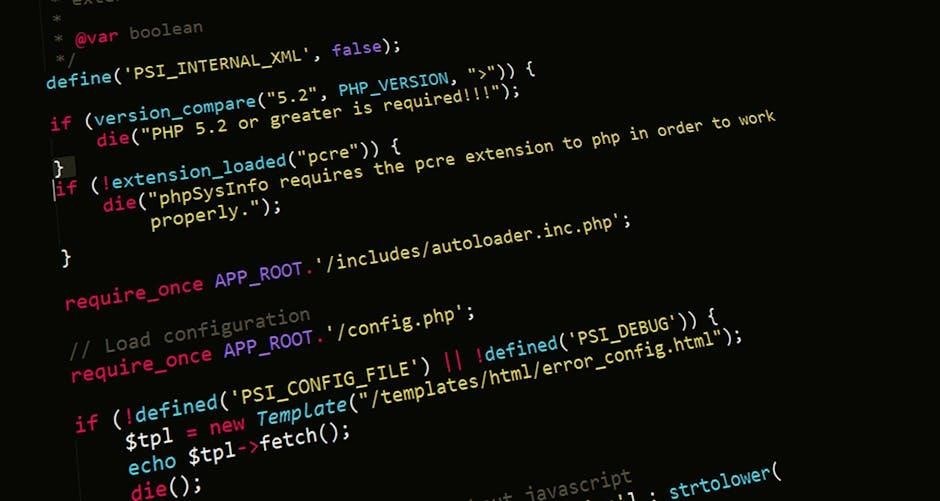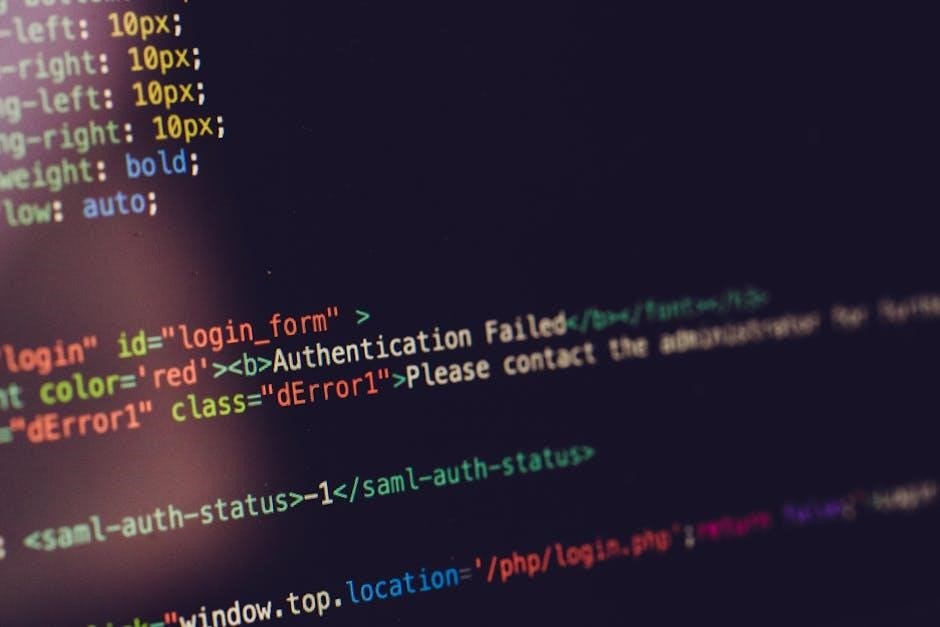Mitsubishi VRF (Variable Refrigerant Flow) systems are highly efficient HVAC solutions, offering advanced temperature control and energy savings. These systems rely on precise error codes for diagnostics, ensuring optimal performance and quick troubleshooting. Understanding these codes is essential for maintaining system reliability and addressing issues promptly.
1.1 Overview of VRF Technology
Mitsubishi VRF (Variable Refrigerant Flow) systems represent a cutting-edge HVAC technology designed for efficient heating and cooling. These systems adjust refrigerant flow according to real-time demand, optimizing energy use and providing precise temperature control. Unlike traditional systems, VRF technology allows for simultaneous heating and cooling in different zones, enhancing flexibility and comfort. Its modular design enables easy installation and scalability, making it ideal for both residential and commercial applications. Advanced inverter technology ensures smooth operation, reducing noise and improving efficiency. VRF systems also offer environmental benefits by minimizing energy consumption and reducing greenhouse gas emissions. Their adaptability and energy-saving capabilities make them a preferred choice for modern buildings, ensuring reliable performance and reduced operational costs.
1.2 Importance of Error Codes in VRF Systems
Error codes play a critical role in Mitsubishi VRF systems by providing clear diagnostics for technicians and users. These codes identify specific issues, such as sensor malfunctions, communication errors, or system malfunctions, enabling quick troubleshooting and minimizing downtime. By understanding error codes, maintenance personnel can address problems accurately, preventing minor issues from escalating into major repairs. Regular monitoring of error codes also supports preventive maintenance, ensuring optimal system performance and extending equipment lifespan. Additionally, error codes help in maintaining energy efficiency and operational reliability, which are essential for both residential and commercial applications. Their importance lies in their ability to streamline diagnostics, reduce repair costs, and ensure continuous system operation, making them indispensable for effective VRF system management.

Understanding Mitsubishi VRF Error Codes
Mitsubishi VRF error codes provide essential insights into system malfunctions, enabling precise diagnostics and efficient repairs. Each code corresponds to specific issues, ensuring targeted solutions for optimal performance.
2.1 Role of Error Codes in Diagnostics
Mitsubishi VRF error codes play a vital role in diagnostics by providing clear indicators of system issues. These codes help technicians quickly identify malfunctions, such as sensor failures or communication errors, enabling targeted repairs. By referencing error codes, professionals can diagnose problems efficiently, minimizing downtime and ensuring system performance. The codes also guide troubleshooting steps, allowing for precise solutions and preventing further complications. Regular monitoring of these codes enhances maintenance practices and prolongs system lifespan. Overall, error codes are essential tools for maintaining the reliability and efficiency of Mitsubishi VRF systems, ensuring optimal operation and addressing issues promptly.
2.2 How Error Codes Enhance System Maintenance
Mitsubishi VRF error codes significantly enhance system maintenance by providing detailed insights into potential issues. These codes allow technicians to identify and address problems early, preventing minor faults from escalating into major breakdowns. Regular analysis of error codes ensures proactive maintenance, reducing unexpected system failures and extending equipment lifespan. By referencing error code guides, maintenance teams can perform targeted repairs, optimizing resource allocation and minimizing downtime. Additionally, error codes facilitate consistent system performance, ensuring energy efficiency and reliable operation. Overall, incorporating error code analysis into maintenance routines improves system reliability, reduces operational costs, and maintains optimal performance, making it a crucial aspect of Mitsubishi VRF system care;

Common Mitsubishi VRF Error Codes
Mitsubishi VRF systems display specific error codes like E03, 1301, 3121, 2500, and 4220, each indicating unique issues. Referencing the Mitsubishi VRF error code PDF guide ensures accurate diagnostics and solutions.
3.1 Error Code E03: Causes and Solutions
Error code E03 in Mitsubishi VRF systems typically indicates a communication fault between the indoor and outdoor units. This issue may arise from loose or disconnected communication wires. To resolve, ensure all connections are secure and check for any damage. Power cycling the system can sometimes reset the error. If the problem persists, consulting the Mitsubishi VRF error code PDF guide or contacting a professional is recommended for detailed troubleshooting and solutions.
3.2 Error Code 1301: Low Pressure Fault
Error code 1301 in Mitsubishi VRF systems indicates a low pressure fault, which is a critical issue requiring immediate attention. This error typically occurs due to insufficient refrigerant levels, often caused by a leak in the system. To resolve this, check the refrigerant lines for any signs of damage or leaks and recharge the refrigerant if necessary. Additionally, ensure the low-pressure sensor is functioning correctly, as a faulty sensor can trigger this error. If the issue persists, consult the Mitsubishi VRF error code PDF guide for detailed troubleshooting steps. Addressing this error promptly is essential to prevent potential system damage and maintain optimal performance. Always consider professional assistance if you’re unsure about the repair process.
3.3 Error Code 3121: Troubleshooting Steps
Error code 3121 in Mitsubishi VRF systems typically indicates a communication error between the indoor and outdoor units. To resolve this, first, check the communication wires for any signs of damage, loose connections, or interference. Ensure the CN3G connector on both units is securely plugged in and free from corrosion. Power down the system for 30 seconds before restarting it to reset the communication link. If the issue persists, refer to the Mitsubishi VRF error code PDF guide for detailed troubleshooting procedures. Additionally, verify that all units are properly configured and synchronized within the VRF system. If you’re unsure, consult a certified HVAC technician to avoid further complications. Regular maintenance and inspections can help prevent such communication faults in the future.
3.4 Error Code 2500: System Communication Issues
Error code 2500 in Mitsubishi VRF systems signifies a system communication issue, often related to the connection between units. This issue arises when there is a disruption in the communication network, preventing proper data exchange. To address this, start by inspecting the communication wires for any damage, loose connections, or interference. Ensure all units are powered on and properly configured within the system. Restarting the system may resolve temporary glitches. If the problem persists, consult the Mitsubishi VRF error code PDF guide for detailed troubleshooting steps. Additionally, verify that all units are synchronized and compatible. In severe cases, professional intervention may be required to restore communication and ensure system stability. Regular checks can help prevent such issues from recurring.
3.5 Error Code 4220: Outdoor Unit Malfunctions
Error code 4220 indicates a malfunction in the outdoor unit of Mitsubishi VRF systems, typically related to sensor or wiring issues. This code often points to problems with the outdoor unit’s communication or operational functions. Common causes include faulty sensors, loose or damaged wiring, or issues with the unit’s control board. To resolve this, inspect the sensors for accuracy and ensure all connections are secure. Check for any blockages or damage to the wiring harness. If the issue persists, consult the Mitsubishi VRF error code PDF guide for detailed troubleshooting steps. In some cases, resetting the system or replacing faulty components may be necessary. Addressing this error promptly ensures optimal system performance and prevents further complications. Regular maintenance can help identify such issues early, minimizing downtime and repair costs.

Troubleshooting Mitsubishi VRF Error Codes
Troubleshooting Mitsubishi VRF error codes involves using diagnostic guides, such as the Mitsubishi VRF error code PDF, to identify and resolve system issues efficiently.
4.1 Interpreting Error Code Meanings

Interpreting Mitsubishi VRF error codes requires a thorough understanding of their meanings, often detailed in the Mitsubishi VRF error code PDF guide. Each code corresponds to specific issues, such as sensor malfunctions or communication errors. By referencing the guide, technicians can identify root causes, like low pressure faults (e.g., error code 1301) or communication issues (e.g., error code 2500). Accurate interpretation ensures timely repairs, preventing system downtime. The PDF guide provides detailed explanations, enabling professionals to diagnose and resolve problems efficiently. Regular updates to these resources ensure technicians stay informed about new error codes and solutions, maintaining system performance and reliability.
4.2 Checking Sensors and Wires
Checking sensors and wires is a critical step in diagnosing Mitsubishi VRF system issues. Faulty sensors can trigger error codes like E03, indicating temperature sensor malfunctions. Technicians should inspect wire connections, especially between indoor and outdoor units, for looseness or damage. The Mitsubishi VRF error code PDF guide recommends using multimeters to verify sensor resistance and voltage levels. Clean or replace sensors as needed to ensure accurate readings. Additionally, checking for signs of wear, corrosion, or electrical interference is essential. Properly functioning sensors and wires are vital for system performance, so regular inspections can prevent errors and maintain efficiency. Referencing the PDF guide helps technicians identify specific wiring issues related to error codes, ensuring precise repairs.
4.3 Verifying Communication Between Units
Verifying communication between indoor and outdoor units is essential for diagnosing Mitsubishi VRF system errors. Error codes like 2500 often indicate communication failures due to wiring issues or loose connections. Technicians should check the communication wires for damage or disconnections and ensure all connectors are securely fastened. Using a multimeter, they can test for continuity and voltage drops. The Mitsubishi VRF error code PDF guide provides detailed steps for verifying communication, including checking the control PCBs and ensuring proper signal transmission. If communication is restored, the system should resume normal operation. Regular checks can prevent such issues, ensuring seamless interaction between units and maintaining overall system efficiency. Proper communication is vital for accurate error code interpretation and effective troubleshooting.

Tools and Resources for Error Code Analysis
Mitsubishi VRF error code analysis relies on tools like PDF guides, online apps, and service manuals, providing detailed troubleshooting and repair solutions for efficient system maintenance.
5.1 Mitsubishi VRF Error Code PDF Guide
The Mitsubishi VRF Error Code PDF Guide is an essential resource for technicians and users, offering comprehensive lists and explanations of error codes. This detailed document provides troubleshooting solutions, diagnostic steps, and repair guidance for various system malfunctions. By referencing this guide, individuals can quickly identify issues such as low pressure faults or communication errors, ensuring efficient resolution. The PDF format allows for easy access and sharing, making it a valuable tool for maintaining system performance and addressing problems promptly. Regular updates ensure the guide remains current with the latest error codes and solutions, supporting optimal system operation and user satisfaction.
5.2 Utilizing Online Apps for Code Lookup
Online apps provide a convenient and efficient way to look up Mitsubishi VRF error codes, enabling quick identification and resolution of system issues. These apps often feature comprehensive databases of error codes, including detailed explanations and troubleshooting steps. Technicians can input specific codes, such as 1301 or E03, to access tailored solutions. Many apps are optimized for mobile devices, allowing on-site diagnostics and repairs. Additionally, some platforms offer real-time updates, ensuring users have access to the latest error code information. This tool is invaluable for HVAC professionals, streamlining the diagnostic process and reducing downtime. By leveraging online apps, users can enhance their troubleshooting efficiency and maintain system performance effectively.
5.3 Referencing Service Handbooks
Service handbooks are essential resources for understanding and resolving Mitsubishi VRF error codes. These detailed guides provide comprehensive lists of error codes, their meanings, and step-by-step troubleshooting procedures. They often include diagrams and technical specifications, making them invaluable for technicians and maintenance personnel. For example, error code 1301, indicating a low-pressure fault, can be quickly identified and addressed using the handbook’s guidance. Regularly updated editions ensure users have access to the latest information, reflecting system enhancements and new error codes. Service handbooks also serve as a primary reference for complex issues, offering in-depth insights that go beyond basic code lookup tools. They are a cornerstone for ensuring accurate diagnostics and efficient repairs, helping to maintain system performance and reliability.
5.4 YouTube Tutorials and Videos
YouTube offers a wealth of tutorials and videos dedicated to Mitsubishi VRF error codes, providing visual and practical guidance for technicians and users. These resources often include step-by-step explanations of common error codes, such as 2500 and 3121, along with real-life examples of troubleshooting and repair. Many channels specialize in HVAC systems, offering detailed walkthroughs of error code diagnostics and solutions. Videos also cover topics like system communication issues, sensor malfunctions, and outdoor unit errors, making them invaluable for hands-on learning. Additionally, official Mitsubishi channels and experienced technicians share tips for interpreting error codes and performing preventive maintenance. These tutorials are particularly useful for visual learners and those seeking to enhance their understanding of VRF systems beyond written guides, ensuring issues are resolved efficiently and effectively.

Preventive Maintenance and Error Avoidance
Regular inspections, cleaning air filters, and scheduling professional maintenance ensure Mitsubishi VRF systems operate efficiently, minimizing error risks and extending system lifespan through proactive care.
6.1 Regular System Inspections
Regular system inspections are critical for preventing errors in Mitsubishi VRF systems. Technicians should check for loose connections, sensor accuracy, and refrigerant levels. Cleaning condenser coils and ensuring proper airflow can prevent common issues like low pressure faults (Error Code 1301). Inspecting communication wires between indoor and outdoor units helps avoid errors like Code 2500, which indicate communication failures. Additionally, verifying the integrity of the power supply circuit prevents malfunctions. These inspections, when done systematically, help identify potential problems early, reducing downtime and ensuring optimal performance. By addressing issues before they escalate, regular inspections play a vital role in maintaining system reliability and efficiency.
6.2 Cleaning and Replacing Air Filters
Cleaning and replacing air filters is essential for maintaining Mitsubishi VRF system efficiency and preventing errors. Dirty filters can restrict airflow, leading to increased pressure and potential faults like Error Code 1301 (low pressure fault). Regularly cleaning or replacing filters ensures proper system operation and prevents overheating, which can trigger error codes related to sensor malfunctions. Clogged filters may also cause communication issues between units, such as Error Code 2500. By maintaining clean filters, users can enhance system performance, reduce energy consumption, and prevent common error codes. This simple yet crucial step is a key part of proactive maintenance, ensuring the system runs smoothly and efficiently while minimizing the risk of errors.
6.3 Scheduling Professional Maintenance
Scheduling regular professional maintenance is vital for ensuring the optimal performance and longevity of Mitsubishi VRF systems. Technicians can identify potential issues before they escalate, preventing error codes like 4220 (outdoor unit malfunctions) and 3121 (sensor-related issues). During maintenance, professionals inspect sensors, wiring, and communication lines, addressing problems that might lead to system faults. They also verify refrigerant levels and check for leaks, which can cause low-pressure faults (Error Code 1301). Additionally, professionals ensure proper communication between indoor and outdoor units, preventing errors like 2500. Regular maintenance not only resolves existing issues but also enhances system efficiency, reducing energy costs and extending equipment lifespan. By scheduling these services, users can avoid unexpected breakdowns and ensure their VRF system operates reliably year-round.
7.1 Summary of Key Points
Mitsubishi VRF error codes play a crucial role in diagnosing and resolving system issues promptly. Understanding these codes enhances maintenance efficiency, ensuring optimal performance. Common errors like E03, 1301, 3121, 2500, and 4220 indicate specific malfunctions, such as low pressure faults or communication issues. Troubleshooting involves interpreting codes, checking sensors, and verifying unit communication. Utilizing resources like the Mitsubishi VRF Error Code PDF guide, online apps, and service handbooks simplifies the process. Regular maintenance, including filter cleaning and professional inspections, prevents errors and extends system lifespan. Proactive approaches ensure reliability and energy efficiency, making Mitsubishi VRF systems a robust choice for HVAC needs. By mastering error codes, users can address problems swiftly, minimizing downtime and ensuring consistent comfort.
7.2 Importance of Proactive Maintenance
Proactive maintenance is essential for ensuring the longevity and efficiency of Mitsubishi VRF systems. Regular inspections and preventive measures can identify potential issues before they escalate, reducing downtime and repair costs. Cleaning or replacing air filters, checking sensors, and verifying communication between units are critical tasks. Scheduling professional maintenance annually helps maintain optimal performance and prevents error codes like 2500 or 4220, which indicate communication or outdoor unit malfunctions. Additionally, referring to the Mitsubishi VRF Error Code PDF guide and online resources empowers users to address problems swiftly. By prioritizing proactive maintenance, building managers and technicians can ensure consistent system operation, energy efficiency, and reliability, ultimately extending the lifespan of the VRF system and maintaining a comfortable environment;

Additional Resources for Further Learning
Explore Mitsubishi’s official website, download the latest PDF guides, and engage with HVAC forums for in-depth knowledge on VRF error codes and system optimization.

8.1 Downloading the Latest PDF Guides
Downloading the latest Mitsubishi VRF error code PDF guides is essential for comprehensive troubleshooting and maintenance. These guides provide detailed explanations of error codes, enabling quick diagnosis and resolution. They include lists of common errors, such as 1301 (low pressure fault) and E03 (communication issues), along with step-by-step solutions. The PDFs also cover advanced diagnostic techniques and preventive maintenance tips to ensure system efficiency. Available on Mitsubishi’s official website and HVAC forums, these resources are indispensable for technicians and facility managers. Regular updates ensure the guides reflect the latest system improvements and error code definitions, making them a reliable tool for optimizing VRF performance and minimizing downtime.
8.2 Exploring Mitsubishi’s Official Website
Mitsubishi’s official website offers a wealth of resources for understanding and resolving VRF error codes. The site features detailed product manuals, technical bulletins, and error code lists specific to various VRF models. Users can access troubleshooting guides for common issues like error code 2500 (communication faults) and error code 4220 (outdoor unit malfunctions); Additionally, the website provides instructional videos, FAQs, and software tools for advanced diagnostics. Registered users can also benefit from exclusive content, including updated error code databases and system optimization tips. Navigating the site is user-friendly, allowing technicians and building managers to quickly locate the information they need to maintain and repair Mitsubishi VRF systems efficiently.
8.3 Engaging with HVAC Forums and Communities

Engaging with HVAC forums and communities is a valuable resource for resolving Mitsubishi VRF error codes. Platforms like HVAC-Talk, Reddit’s r/HVAC, and specialized HVAC forums host discussions where professionals share experiences and solutions. Users can ask questions about specific error codes, such as E03 or 1301, and receive detailed advice from experienced technicians. These communities often provide real-world insights, troubleshooting tips, and access to shared resources like error code charts and repair guides. Active participation allows technicians to stay updated on common issues and learn from others’ experiences. Additionally, many forums offer access to downloadable materials, such as Mitsubishi VRF error code PDFs, further enhancing troubleshooting capabilities. By leveraging these communities, HVAC professionals can gain practical knowledge and improve their diagnostic skills, ensuring efficient system maintenance and repair.

